



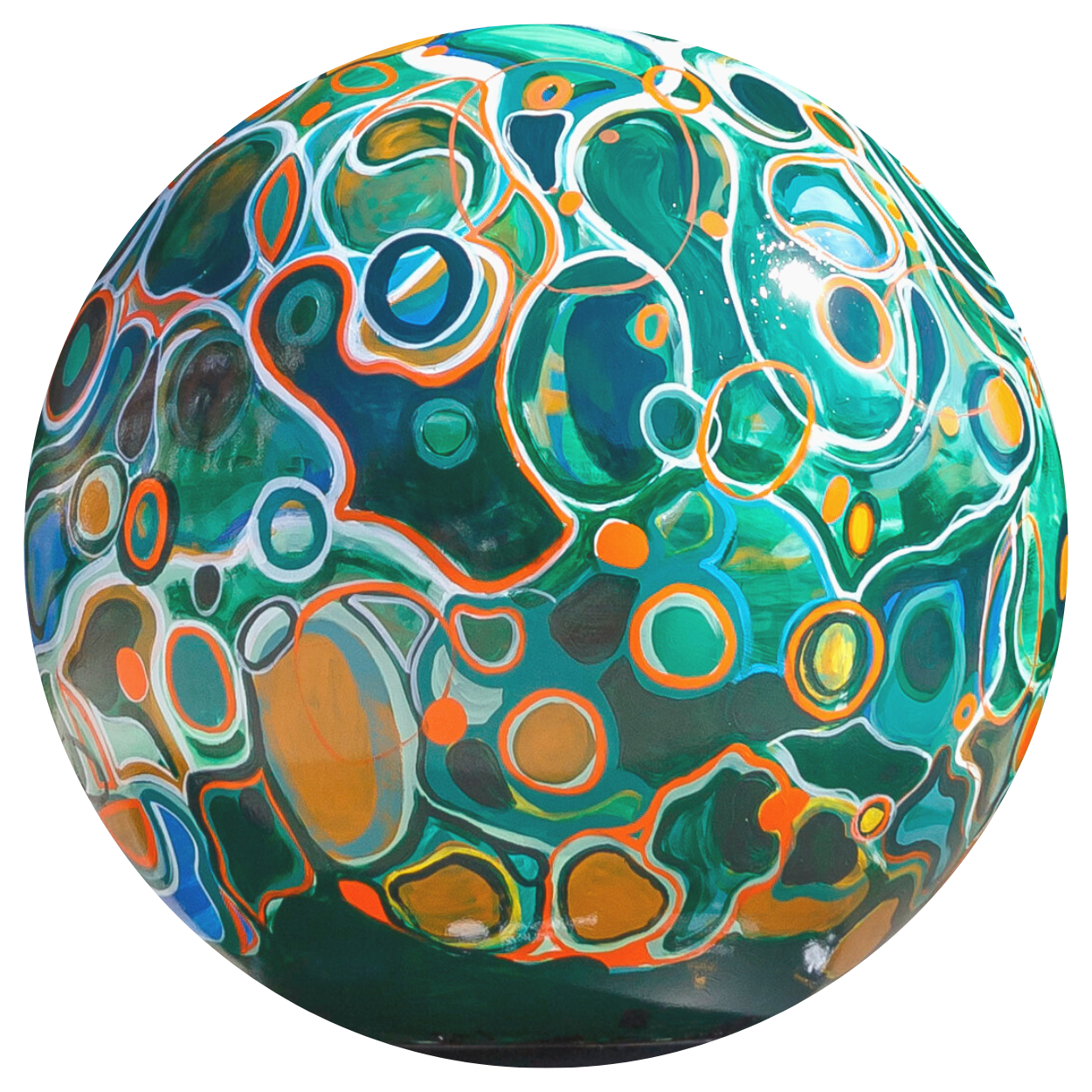
Currents In MotionThis globe evolved from work with local communities in Leeds and responded to the notion of being connected to place. Through conversations it became clear that a sense of movement and journeys were deeply rooted in the experience of community members in Leeds. F... |


| Kirkgate Market |
The work of making racial justice a reality must be rooted in community – in our individual and collective experiences, hopes and contributions. Rosanna’s design was created in response to dialogue and workshops with local communities.
This globe evolved from work with local communities in Leeds and responded to the notion of being connected to place.
Through conversations it became clear that a sense of movement and journeys were deeply rooted in the experience of community members in Leeds. For example, the migration journeys which people made to be here. These journeys often represent tensions and conflicts whilst also documenting family, belonging and a sense of home.
My intention was to try and encapsulate this through a series of mark making, colour choices and allow for the notion of ‘push and pull’ to organically emerge. Through the continued discussions and in the creation of the globe, it has been encouraging to hear a wide range of interpretations. Many have commented on the sea and how it moves, and this echoes back to the idea of migration; others saw dancing feet and related this to Carnival and dancing; while others have commented on the green spaces that are a prevalent and beloved feature of our city.
This city hosts people to whom migration and movement are part of their daily experience. I hope this globe will create conversations around those experiences. Furthermore, I hope it can inspire them to think about what their sense of place is and how it can progress into our shared futures.
Rosanna is a multidisciplinary artist and teacher based in Leeds, Yorkshire. She uses a playful approach to mark-making, incorporating elements of collage, drawing and experimental painting to explore shifting cultural representations of everyday life.
The work of making racial justice a reality must be rooted in community – in our individual and collective experiences, hopes and contributions. Rosanna’s design was created in response to dialogue and workshops with local communities.
This globe evolved from work with local communities in Leeds and responded to the notion of being connected to place.
Through conversations it became clear that a sense of movement and journeys were deeply rooted in the experience of community members in Leeds. For example, the migration journeys which people made to be here. These journeys often represent tensions and conflicts whilst also documenting family, belonging and a sense of home.
My intention was to try and encapsulate this through a series of mark making, colour choices and allow for the notion of ‘push and pull’ to organically emerge. Through the continued discussions and in the creation of the globe, it has been encouraging to hear a wide range of interpretations. Many have commented on the sea and how it moves, and this echoes back to the idea of migration; others saw dancing feet and related this to Carnival and dancing; while others have commented on the green spaces that are a prevalent and beloved feature of our city.
This city hosts people to whom migration and movement are part of their daily experience. I hope this globe will create conversations around those experiences. Furthermore, I hope it can inspire them to think about what their sense of place is and how it can progress into our shared futures.
Rosanna is a multidisciplinary artist and teacher based in Leeds, Yorkshire. She uses a playful approach to mark-making, incorporating elements of collage, drawing and experimental painting to explore shifting cultural representations of everyday life.


| Potternewton Park, Harehills Lane, Leeds |
Founded in 1967 by Arthur France MBE, the Leeds Carnival celebrated its 50th year in 2017. In Arthur's words, the Leeds Carnival was 'the first in the UK to incorporate all three essential elements of authentic West Indian carnival – costumes, music and a masquerade procession.' The festival has built up an illustrious following, going from around 1,000 attendees to over 100,000. The kaleidoscopic procession of music and costumes begins at Potternewton Park and snakes its way via Harehills Lane, Roundhay Road and back up Chapeltown Road back to Potternewton Park. The Leeds Carnival is the highlight of many people's calendars. It offers a recurring opportunity for people to celebrate the food, music and cultures that bind so many people together in the Caribbean-majority community of Chapeltown.
Founded in 1967 by Arthur France MBE, the Leeds Carnival celebrated its 50th year in 2017. In Arthur's words, the Leeds Carnival was 'the first in the UK to incorporate all three essential elements of authentic West Indian carnival – costumes, music and a masquerade procession.' The festival has built up an illustrious following, going from around 1,000 attendees to over 100,000. The kaleidoscopic procession of music and costumes begins at Potternewton Park and snakes its way via Harehills Lane, Roundhay Road and back up Chapeltown Road back to Potternewton Park. The Leeds Carnival is the highlight of many people's calendars. It offers a recurring opportunity for people to celebrate the food, music and cultures that bind so many people together in the Caribbean-majority community of Chapeltown.

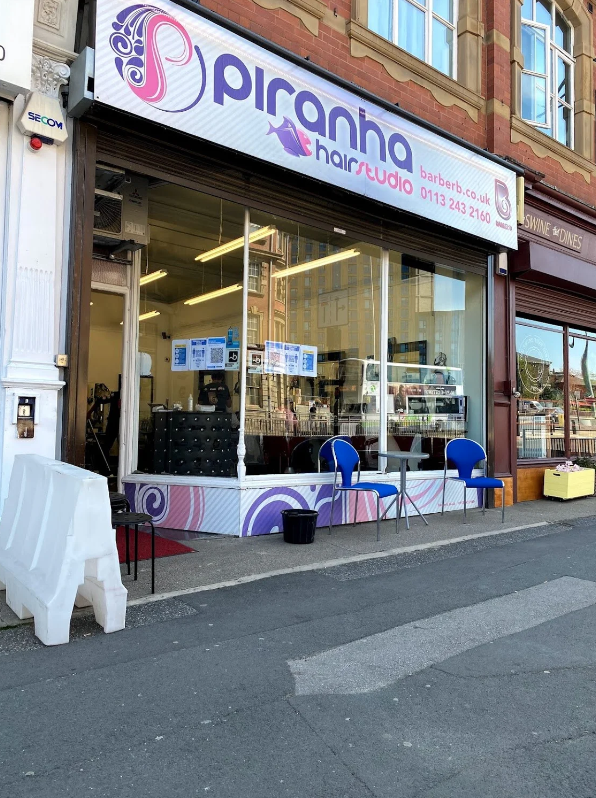
| 60 North St, Leeds LS2 7PN |
Born in Chapeltown, Barber B (Brian Swarray) is a master barber, MD, assessor and educator. He has been cutting hair in Leeds for 30 years. Fascinated by a mysterious Jamaican called Gary and his ability to cut patterns in hair, Barber B did his first haircut on his brother after finding a pair of clippers in a skip. Since then, he has had several shops, won countless competitions, become an international authority on barbering and developed a unique method of training barbers. His team prides themselves on their excellent unisex Afro and European haircuts and as such, his barber shop is a multi-cultural hub. Along with Piranha Hair Studio, Barber B runs the Piranha Barber Academy and uses his barbering to help raise money and awareness for several charities. He was recently awarded a grant by The World Reimagined to collaborate on a play about his life and profession as a mixed-race barber in Leeds.
Image obtained from https://nicelocal.co.uk/leeds/beauty/piranha_hair_studio_and_training_academy/
Born in Chapeltown, Barber B (Brian Swarray) is a master barber, MD, assessor and educator. He has been cutting hair in Leeds for 30 years. Fascinated by a mysterious Jamaican called Gary and his ability to cut patterns in hair, Barber B did his first haircut on his brother after finding a pair of clippers in a skip. Since then, he has had several shops, won countless competitions, become an international authority on barbering and developed a unique method of training barbers. His team prides themselves on their excellent unisex Afro and European haircuts and as such, his barber shop is a multi-cultural hub. Along with Piranha Hair Studio, Barber B runs the Piranha Barber Academy and uses his barbering to help raise money and awareness for several charities. He was recently awarded a grant by The World Reimagined to collaborate on a play about his life and profession as a mixed-race barber in Leeds.
Image obtained from https://nicelocal.co.uk/leeds/beauty/piranha_hair_studio_and_training_academy/


| 18 Commercial St, Leeds LS1 6AL |
Olaudah Equiano (1745–1797) was a writer and Black activist who campaigned for equality through his writings, most notably his autobiography, The Interesting Narrative of the Life of Olaudah Equiano. The book follows Olaudah's life from being enslaved in Nigeria at age 11 to his prominence as a free man in English society. The Leeds Library has an old and rare edition of Equiano's work, which helped gather empathy from the British public by recounting the realities of enslavement. This particular edition of Olaudah's work was printed in Leeds in 1814. It remains a powerful work and an ongoing testament to Olaudah Equiano's skill as one of the first Black authors to be published in Europe.
Image obtained from: https://www.bl.uk/collection-items/the-life-of-olaudah-equinao
Olaudah Equiano (1745–1797) was a writer and Black activist who campaigned for equality through his writings, most notably his autobiography, The Interesting Narrative of the Life of Olaudah Equiano. The book follows Olaudah's life from being enslaved in Nigeria at age 11 to his prominence as a free man in English society. The Leeds Library has an old and rare edition of Equiano's work, which helped gather empathy from the British public by recounting the realities of enslavement. This particular edition of Olaudah's work was printed in Leeds in 1814. It remains a powerful work and an ongoing testament to Olaudah Equiano's skill as one of the first Black authors to be published in Europe.
Image obtained from: https://www.bl.uk/collection-items/the-life-of-olaudah-equinao

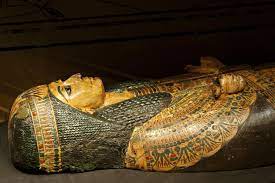
| Millennium Square, Leeds LS2 8BH |
The oldest Black resident in Leeds is Nesyamun, an Egyptian mummy, whose remains are housed within the Leeds City Museum. The 3000-year-old Nubian priest, of the religion Maat, was alive during the reign of pharaoh Ramses XI (c.1099–1069 BC). His mummified remains and casket, which survived a bombing in the Leeds Blitz, have been on display since 1823. Nesyamun's well-preserved remains have drawn crowds for 200 years. In 2020, researchers brought a part of Nesyamun back to life. Using 3D printing, a nationwide team from several universities, constructed a synthetic recreation of Nesyamun's vocal tracts. This enabled the researchers to generate a vowel sound that Nesyamun would have made in his lifetime. Speaking on Egyptian beliefs, Curator of Archaeology Katherine Baxter explained, ‘to speak the name of the dead is to make them live again’. That people still marvel at and know Nesyamun gives this belief a poignancy 3000 years later.
Image obtained from: https://news.leeds.gov.uk/news/leeds-museums-and-galleries-object-of-the-week-coffin-of-nesyamun
The oldest Black resident in Leeds is Nesyamun, an Egyptian mummy, whose remains are housed within the Leeds City Museum. The 3000-year-old Nubian priest, of the religion Maat, was alive during the reign of pharaoh Ramses XI (c.1099–1069 BC). His mummified remains and casket, which survived a bombing in the Leeds Blitz, have been on display since 1823. Nesyamun's well-preserved remains have drawn crowds for 200 years. In 2020, researchers brought a part of Nesyamun back to life. Using 3D printing, a nationwide team from several universities, constructed a synthetic recreation of Nesyamun's vocal tracts. This enabled the researchers to generate a vowel sound that Nesyamun would have made in his lifetime. Speaking on Egyptian beliefs, Curator of Archaeology Katherine Baxter explained, ‘to speak the name of the dead is to make them live again’. That people still marvel at and know Nesyamun gives this belief a poignancy 3000 years later.
Image obtained from: https://news.leeds.gov.uk/news/leeds-museums-and-galleries-object-of-the-week-coffin-of-nesyamun

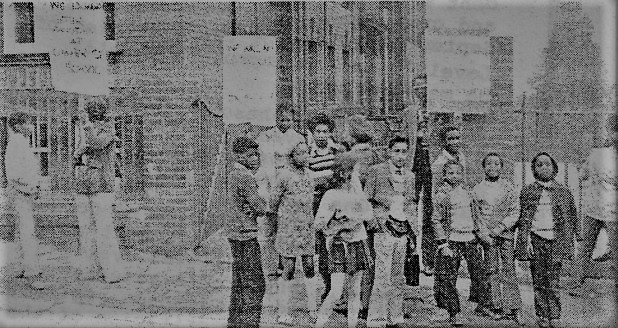
| Cowper St, London EC2A 4SH |
In 1973, after facing many struggles to transform what they felt was a racist school system, the Caribbean parents of Cowper Street School organised a strike. In the early 1970s, concerns were growing amongst parents about the education of their kids and racism they were subjected to in the classroom. They consulted the United Caribbean Association (UCA) and t he West Indian Afro Brotherhood, who recorded complaints about the school’s headteacher who was known to have stated that ’black pupils have lower foreheads and less cranial capacity than the white pupils’. Discussions led to parents demanding: the removal of the headmaster; more Black governors ;better contact between the headmaster, parents and staff; improved facilities; a reduction in teacher turnover; more black teachers; and members of the Black community to be invited to speak to the children to give them more motivation. However, these demands were unsuccessful and a strike ensued.
Image obtained from: https://leedsmasmedia.wordpress.com/tag/leeds-west-indian-carnival/page/4/
In 1973, after facing many struggles to transform what they felt was a racist school system, the Caribbean parents of Cowper Street School organised a strike. In the early 1970s, concerns were growing amongst parents about the education of their kids and racism they were subjected to in the classroom. They consulted the United Caribbean Association (UCA) and t he West Indian Afro Brotherhood, who recorded complaints about the school’s headteacher who was known to have stated that ’black pupils have lower foreheads and less cranial capacity than the white pupils’. Discussions led to parents demanding: the removal of the headmaster; more Black governors ;better contact between the headmaster, parents and staff; improved facilities; a reduction in teacher turnover; more black teachers; and members of the Black community to be invited to speak to the children to give them more motivation. However, these demands were unsuccessful and a strike ensued.
Image obtained from: https://leedsmasmedia.wordpress.com/tag/leeds-west-indian-carnival/page/4/

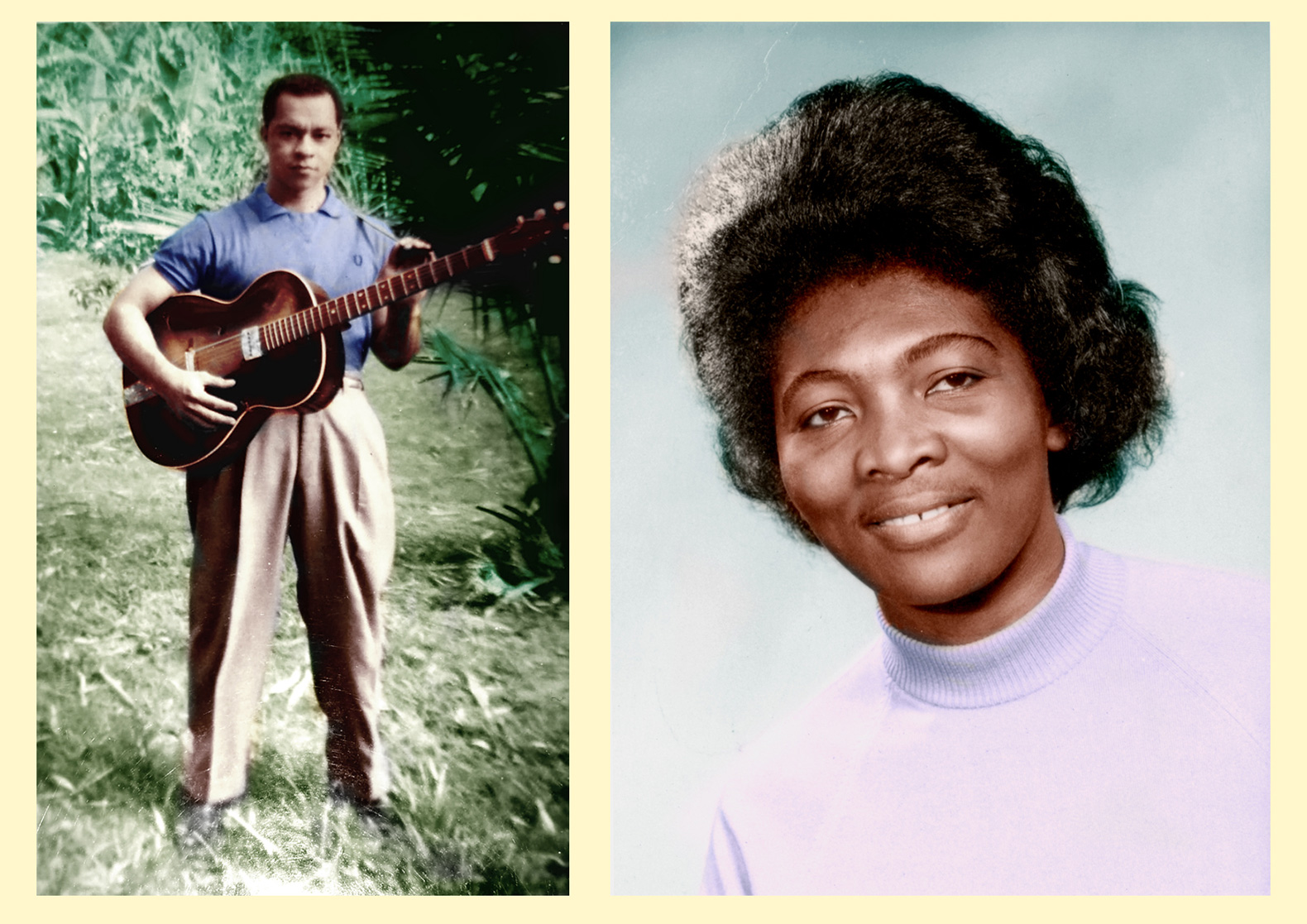
| 16 Harehills Avenue, Leeds, West Yorkshire, LS7 4EU |
Becoming bright and valued members of the community, Veryl and George Harriott moved to Leeds in 1960 from Jamaica. George was an accomplished musician who played backing for greats such as Fats Domino, Sam Cooke and Harry Belafonte. In England, he continued his musical path and is often credited by many Black Leeds musicians as the person who taught them guitar. Veryl became a keen activist in Leeds. Along with her work teaching Black history classes from their Harehills home, Veryl helped the homeless and was an engine for community empowerment. Veryl was instrumental in the formation of the Chapeltown Citizen's Advice Bureau and the 1968 Race Relations Act. She wass the first Black person to become managing director of a Citizen's Advice Bureau.
Image obtained from: https://www.jamaicasocietyleeds.co.uk/back_to_life/george-solomon-harriott-1926-1999-and-veryl-alletta-harriott-nee-cruise-1934-2018/
Becoming bright and valued members of the community, Veryl and George Harriott moved to Leeds in 1960 from Jamaica. George was an accomplished musician who played backing for greats such as Fats Domino, Sam Cooke and Harry Belafonte. In England, he continued his musical path and is often credited by many Black Leeds musicians as the person who taught them guitar. Veryl became a keen activist in Leeds. Along with her work teaching Black history classes from their Harehills home, Veryl helped the homeless and was an engine for community empowerment. Veryl was instrumental in the formation of the Chapeltown Citizen's Advice Bureau and the 1968 Race Relations Act. She wass the first Black person to become managing director of a Citizen's Advice Bureau.
Image obtained from: https://www.jamaicasocietyleeds.co.uk/back_to_life/george-solomon-harriott-1926-1999-and-veryl-alletta-harriott-nee-cruise-1934-2018/


| 277 Chapeltown Road |
The Jamaica Society launched in 1977. It has since gone on to become one of the most respected of all such societies in the Jamaican diaspora. The renowned group keeps Jamaican culture alive, celebrating both the integration and diversity of Jamaica and Leeds. Since its foundations, created by six first-generation Jamaicans, the society has tackled a broad range of welfare issues, including, initiatives related to health and crime, cultural activities, children’s events and community fundraising. Since 1989, the society has been based at Jamaica House, 277 Chapeltown Road. The Society is a bastion of community spirit and remains an enduring pillar of resilience and connection within the Afro-Caribbean community of Leeds.
Image obtained from: https://jamaicasocietyleeds.wordpress.com/
The Jamaica Society launched in 1977. It has since gone on to become one of the most respected of all such societies in the Jamaican diaspora. The renowned group keeps Jamaican culture alive, celebrating both the integration and diversity of Jamaica and Leeds. Since its foundations, created by six first-generation Jamaicans, the society has tackled a broad range of welfare issues, including, initiatives related to health and crime, cultural activities, children’s events and community fundraising. Since 1989, the society has been based at Jamaica House, 277 Chapeltown Road. The Society is a bastion of community spirit and remains an enduring pillar of resilience and connection within the Afro-Caribbean community of Leeds.
Image obtained from: https://jamaicasocietyleeds.wordpress.com/

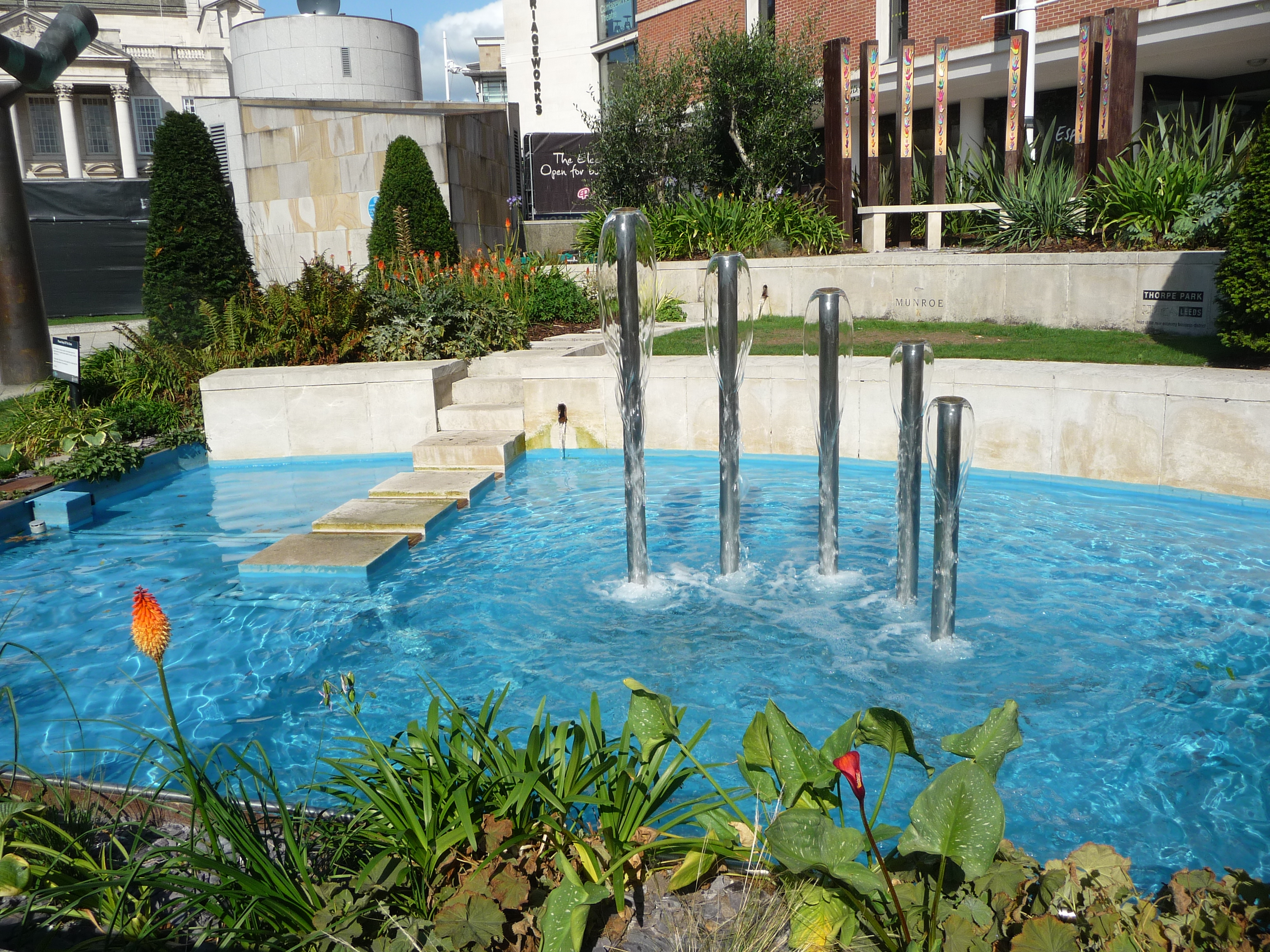
| 5 Calverley St, Leeds LS1 3DA |
The Mandela Garden was created in 1983 in support of Nelson Mandela's stand against South African apartheid. Dedicated to Mandela on 10th December 1983, the garden opened whilst he was still in prison. During a rededication ceremony on April 30, 2001, when he visited the gardens, Nelson Mandela was made an Honorary Freeman of Leeds. The event was attended by over 5000 people. In 2004, the gardens were put forward as an entry into the Chelsea Flower Show, with plants indigenous to both Britain and South Africa adorning the flower beds. The gardens are a celebration of Nelson Mandela's monumental contribution to human rights and racial equality.
Image by Immanuel Giel ( Creative Commons CC0 1.0 )
The Mandela Garden was created in 1983 in support of Nelson Mandela's stand against South African apartheid. Dedicated to Mandela on 10th December 1983, the garden opened whilst he was still in prison. During a rededication ceremony on April 30, 2001, when he visited the gardens, Nelson Mandela was made an Honorary Freeman of Leeds. The event was attended by over 5000 people. In 2004, the gardens were put forward as an entry into the Chelsea Flower Show, with plants indigenous to both Britain and South Africa adorning the flower beds. The gardens are a celebration of Nelson Mandela's monumental contribution to human rights and racial equality.
Image by Immanuel Giel ( Creative Commons CC0 1.0 )


| Woodhouse, Leeds LS2 9JT |
Nigerian playwright, novelist, poet, essayist and Nobel Laureate Wole Soyinka is an esteemed alumnus of the University of Leeds. Following his time as a student at the university, Soyinka began a promising career as a playwright in London. Moving back to Nigeria to continue his development as a writer, Soyinka was caught up in the currents of conflict between Nigeria and Biafrans. His political activities meant at the outbreak of the civil war, he was imprisoned. Although he spent 22 of the 26 months of his incarceration in solitary confinement, Soyinka managed to generate an impressive body of poetry, either through memory or on scraps of paper, which condemned the Nigerian government. Following his release in 1969, Soyinka continued his work as a writer and was awarded the Nobel Prize for Literature in 1986. It was the first Nobel Prize awarded to an African writer.
(Image By Frankie Fouganthin - Own work, CC BY-SA 4.0)
Nigerian playwright, novelist, poet, essayist and Nobel Laureate Wole Soyinka is an esteemed alumnus of the University of Leeds. Following his time as a student at the university, Soyinka began a promising career as a playwright in London. Moving back to Nigeria to continue his development as a writer, Soyinka was caught up in the currents of conflict between Nigeria and Biafrans. His political activities meant at the outbreak of the civil war, he was imprisoned. Although he spent 22 of the 26 months of his incarceration in solitary confinement, Soyinka managed to generate an impressive body of poetry, either through memory or on scraps of paper, which condemned the Nigerian government. Following his release in 1969, Soyinka continued his work as a writer and was awarded the Nobel Prize for Literature in 1986. It was the first Nobel Prize awarded to an African writer.
(Image By Frankie Fouganthin - Own work, CC BY-SA 4.0)

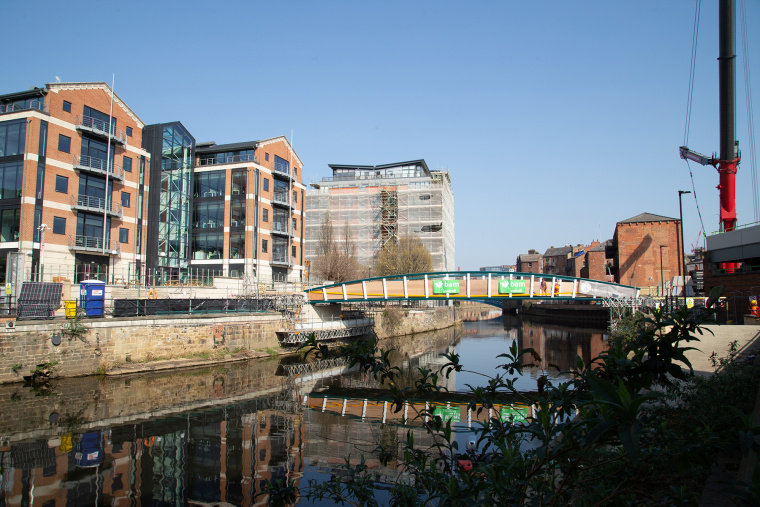
Arriving in Hull from Nigeria as a stowaway in 1949, David Oluwale was arrested and sent to prison. A transfer to Armley prison brought David here to Leeds. He went on to spend the next 20 years in the city, which was not always welcoming. An altercation resulted in a two-month prison sentence for David. In prison, his behaviour was deemed strange. Ultimately, David was sectioned in Menston Asylum for 8 years. On David's release, his mental health had deteriorated. Sleeping rough he was repeatedly harassed by two police officers, Ellerker and Kitching. They would urinate on him, beat him and set fire to the newspaper on which he slept. On 4 May 1969, David was found dead in the River Aire. The two officers were tried and convicted of actual bodily harm but acquitted of a manslaughter charge. This blue plaque acknowledges David's human worth and commemorates his repeated resistance against the brutality which eventually took his life.
Image obtained from: https://www.bam.com/en/press/press-releases/2022/3/key-milestone-as-stunning-david-oluwale-tribute-bridges-the-gap?position=0&list=8nOQP45KXwrhqBAQfAYCeiIDmli_S7zR-eb8IhzuifU
Arriving in Hull from Nigeria as a stowaway in 1949, David Oluwale was arrested and sent to prison. A transfer to Armley prison brought David here to Leeds. He went on to spend the next 20 years in the city, which was not always welcoming. An altercation resulted in a two-month prison sentence for David. In prison, his behaviour was deemed strange. Ultimately, David was sectioned in Menston Asylum for 8 years. On David's release, his mental health had deteriorated. Sleeping rough he was repeatedly harassed by two police officers, Ellerker and Kitching. They would urinate on him, beat him and set fire to the newspaper on which he slept. On 4 May 1969, David was found dead in the River Aire. The two officers were tried and convicted of actual bodily harm but acquitted of a manslaughter charge. This blue plaque acknowledges David's human worth and commemorates his repeated resistance against the brutality which eventually took his life.
Image obtained from: https://www.bam.com/en/press/press-releases/2022/3/key-milestone-as-stunning-david-oluwale-tribute-bridges-the-gap?position=0&list=8nOQP45KXwrhqBAQfAYCeiIDmli_S7zR-eb8IhzuifU


| Woodhouse, Leeds LS2 9JT |
Pablo Fanque was a circus performer, horse trainer and the first Black man to own a circus in England. Born in Norwich in 1810, William Darby took on the stage name Pablo Fanque, performing in many cities and often in Leeds. An adept equestrian, he would teach horses to dance. A tragic accident during a circus performance, where 600 people fell through the wooden floor to the ticket office, crushed Pablo's wife, Suzannah Darby, to death. Suzannah had a monument erected and following his illustrious career, Pablo ensured he was buried in Leeds next to her. His funeral was attended by over 10,000 people. Pablo's story resonated long after his death. He inspired a song appearing in the lyrics of ‘Being For the Benefit of Mr Kite!’ by The Beatles.
(Image By Betty Longbottom, CC BY-SA 2.0)
Pablo Fanque was a circus performer, horse trainer and the first Black man to own a circus in England. Born in Norwich in 1810, William Darby took on the stage name Pablo Fanque, performing in many cities and often in Leeds. An adept equestrian, he would teach horses to dance. A tragic accident during a circus performance, where 600 people fell through the wooden floor to the ticket office, crushed Pablo's wife, Suzannah Darby, to death. Suzannah had a monument erected and following his illustrious career, Pablo ensured he was buried in Leeds next to her. His funeral was attended by over 10,000 people. Pablo's story resonated long after his death. He inspired a song appearing in the lyrics of ‘Being For the Benefit of Mr Kite!’ by The Beatles.
(Image By Betty Longbottom, CC BY-SA 2.0)

Login or Register to track the Globes you visit for chance to win a FREE copy of The World Reimagined book!
Find Out More


Artist Globe |
Learning Globe |
Points of Interest |